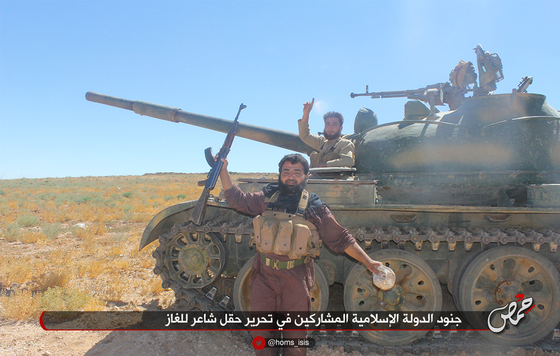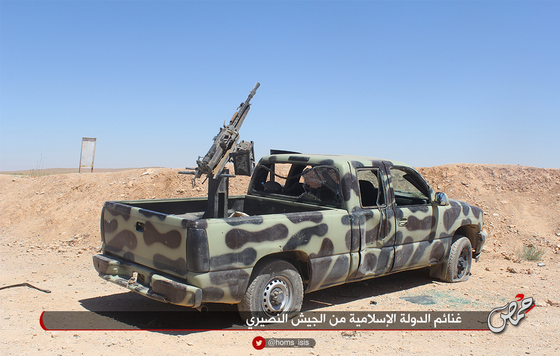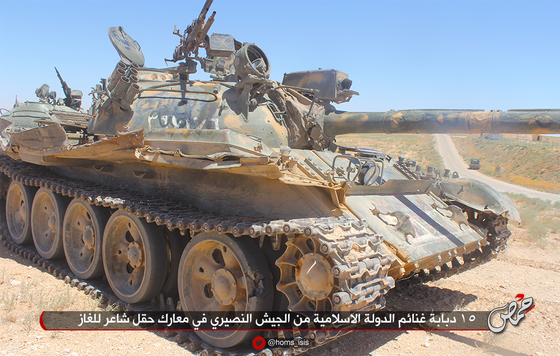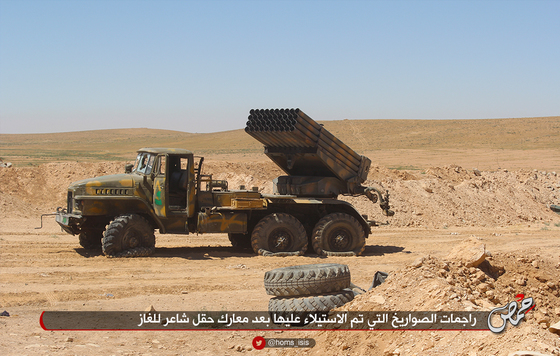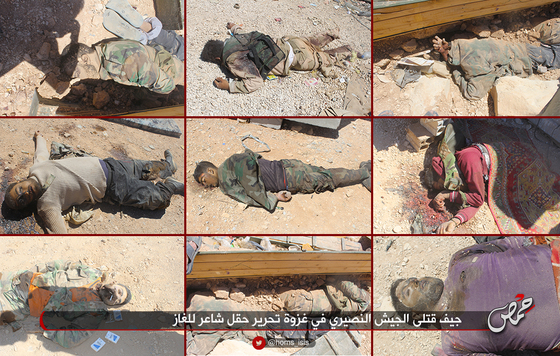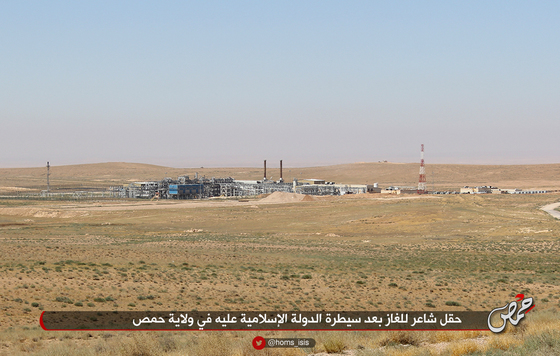 The al Sha’er gas field. Image from Islamic State statement.
The al Sha’er gas field. Image from Islamic State statement.
The Islamic State’s media wing in Wilayat Homs released a statement early this week on the recent fighting around the al Sha’er gas field in central Syria. The statement, titled “A Pictured Report from the Invasion of the al Sha’er gas field,” includes a summary of the battles as well as photos of their aftermath [see below].
Reports began to surface last week indicating that on the evening of July 16, the Islamic State mounted an attack on the al Sha’er gas field with a 2,000-man force. The gas field is located 110 kilometers east of Homs, slightly northwest of the ancient city of Palmyra (Tadmur) in central Syria. According to media reports, the initial attack resulted in the deaths of 270 workers and members of the National Defense Force (NDF), a paramilitary group that is part of the Syrian military. Some of those killed in that attack were executed after their capture by IS fighters. The Syrian Observatory for Human Rights confirmed that 270 individuals were killed in the initial battles at the gas field, including 40 IS fighters. The Syrian daily Al Watan reported that 60 NDF soldiers were killed in the initial attack.
Fighting continued at the al Sha’er gas field after the Islamic State seized the facility on July 17, and Syrian military reinforcements were reportedly sent to reclaim the gas field on July 19. By July 21, media outlets confirmed that an additional 100 people were killed in ongoing clashes at the field between IS fighters and forces of the Syrian regime. The Syrian Observatory for Human Rights claimed that 60 Syrian soldiers were killed on July 19 in fighting close to the gas field. Reports also suggested that the Syrian air force was conducting air strikes in the area to pave the way for ground troops to retake the facility.
The fighting at the al Sha’er gas field has been described by the Syrian Observatory for Human Rights as the “largest” between IS and Syrian government forces since the beginning of the year. Although official Syrian statements did not confirm the fighting at al Sha’er initially, the governor of Homs province, Talal Barazani, told AFP on July 17 that “[t]he armed men were present in the area beforehand, but they have now expanded their area of control with this new operation.”
The loss of the al Sha’er gas field, which received foreign investments from international corporations such as Petro-Canada, constitutes a major blow to the Syrian regime. This latest development comes just weeks after IS fighters consolidated their control over the oil-rich province of Deir al Zour in eastern Syria, bordering Iraq.
The IS report on the seizure of the al Sha’er gas field underscores the importance Islamic State decision makers attach to the takeover of the facility and its surrounding areas. The statement describes the area around the field, known as the al Sha’er region, as “strategic” and calls the gas field “one of the largest and most important gas fields for the nusayri regime.” The report claims that other strategic energy sites are located in the al Sha’er region, including “a gas pumping station for the Hayyan field in al Furqlus that feeds, in turn, the coastal and southern area as well as a number of oil wells.”
The IS report claims that the “Invasion of the al Sha’er gas field” resulted in the deaths of more than 300 regime soldiers and boasts that the regime itself recognized 90 casualties among its ranks and announced it did not know the fate of 270 others. The IS report also details the booty it acquired as a result of the offensive, including 15 tanks, two rocket launchers, and 40 Grad rockets.
The photos below were included in the IS report:
“Soldiers of the Islamic State who participated in the liberation of the al Sha’er gas field”
“Islamic State booty from the nusayri military”
“15 tanks are booty for the Islamic State from the nusayri military in the battles for the al Sha’er gas field”
“Rocket launchers seized after the battles for the al Sha’er gas field”
“The corpses of the dead among the nusayri military in the liberation invasion of the al Sha’er gas field”

